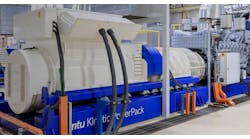Editor’s Note: Here we profile the Buffalo-Niagara microgrid in our series on the NY Prize Stage 2 winners, which each received $1 million. The 11 proposals are now vying to win build-out funds in Stage 3 of the $40 million competition.
SolarCity’s September 2014 announcement that it would build a solar photovoltaic (PV) gigafactory in Buffalo, New York stoked hopes of a manufacturing and industrial revival in the city, across the state and beyond. The decision was most fitting: Buffalo was the first U.S. city to receive hydroelectric power from nearby Niagara Falls (in 1896) and use it for electric lighting, earning it the nickname the City of Light.
As significant as it is, SolarCity’s investment is but one example of New York’s strategic policy framework – Reforming the Energy Vision (REV) – to revitalize local economies and communities through distributed energy, smart grid and clean-tech.
The NY Prize serves as a keystone for achieving NY-REV goals, and Buffalo is home to two of 11 NY Prize Stage 2 contenders vying to advance to the third and final round in the $40 million challenge.
The NY Prize Buffalo-Niagara Medical Campus (BNMC) community microgrid project is notable, and particularly challenging, in several respects.
A microgrid of multiplicity
Kenneth Horne, a director at Navigant, pointed out the significance of the number and diversity of individual BNMC organizations participating in the project.
“Unlike many projects with a single campus owner or a government agency playing a coordinating role, here you have public or quasi-public and private sector organizations and distributed energy assets collaborating with BNMC, a non-profit which in and of itself is made up of 13 individual medical services organizations,” Horne said.
BNMC serves as the umbrella organization of the anchor institutions that make up the Buffalo Niagara Medical Campus. Located within the 120-acre campus bordering Allentown, the Fruit Belt and Downtown Buffalo, the organization fosters conversation and collaboration among member institutions, partners and the community. Its aim is to address critical issues, such as energy, entrepreneurship, access and transportation, workforce and procurement, neighborhoods, and healthy communities, according to BNMC strategic adviser Paul Tyno and lead project partner Black & Veatch (B&V).
In addition to encompassing many organizations, the Buffalo-Niagara microgrid includes a range of resources — existing diesel generators, expansion of a water-driven thermal energy loop, a new combined heat and power (CHP) system and rooftop solar power on-site and in the adjacent Fruit Belt neighborhood.
“Balancing all the respective individual organizations’ interests and pulling together this mix of institutional energy assets, then adding to, enhancing and overlaying all that with a microgrid control platform to form a single, coherent microgrid is an inherently complex and challenging task,” Horne told Microgrid Knowledge.
Dean Weng, senior project engineer at the Electric Power Research Institute (EPRI), which is playing a key role in project development, added that the microgrid’s concept “is quite unique as it encompasses a wide variety of different end-customers (load types).”
“The microgrid boundary includes typical hospital functions such as in-patient, out-patient and emergency procedures, a new teaching hospital, biomedical & cancer research facilities and also a low-income neighborhood (Fruit Belt),” Weng said.
The number and variety of distributed energy resources already in place serve as pillars supporting project economics and its capacity to realize NY Prize challenge goals.
“The BNMC campus is also well suited for implementing DER assets, especially gas-based generators capable of combined heat and power,” he said.
In addition, he noted that “the campus already possesses an extensive network of steam as well as chilled water infrastructure (i.e. looped piping) that serves several of the largest buildings within the campus.”
The BNMC project team assessed the potential to expand the thermal loop to include additional campus buildings as part of the project’s stage one conceptual design. As Weng explained: “The load diversity combined with the cross-sharing of thermal assets will allow larger generators to be installed (achieving greater economies of scale) as well as allow them to run more efficiency (near maximum power output).
In addition, the BNMC site has the potential for installation of additional solar PV on building rooftops, including parking garages. Installation of battery storage units could help support the microgrid during island mode operations by handling transient PV generation and load, as well as the transition to island mode and system ‘resychronization,’ Weng said.
[clickToTweet tweet=”What sets the Buffalo-Niagara #microgrid apart” quote=”What sets the Buffalo-Niagara #microgrid apart”]
Close working relationship with utility
Navigant Energy’s Horne also highlighted the close working relationship between BNMC and local distribution utility National Grid as another element that could distinguish the BNMC project from other stage two NY Prize proposals.
Outside of NY Prize, National Grid was granted an exception to the NY State rule prohibiting distribution utilities from owning generation assets when it submitted a NY-REV distributed energy project proposal. That paved the way for National Grid being awarded NY-REV project funding to install and own rooftop solar power capacity in the historic Fruit Belt community.
In addition to winning NY Prize funds, the BNMC site has been the beneficiary of project funding from NYSERDA, the US Department of Energy and utilities to do with several facets of DER and microgrid implementation, integration, and controls, EPRI’s according to Weng.
For instance, BNMC is included as a designated DER site in National Grid’s NY-REV project award. The utility may wind up taking a direct stake in the BNMC NY Prize microgrid project as well.
The big picture for the Buffalo-Niagara microgrid
From a broad-based perspective, the BNMC initiative focuses on developing the campus and surrounding areas as a self-sustainable energy hub able to offset utility outages or natural disasters enhancing reliability and resiliency, according to BNMC’s Tyno and B&V summarized.
With these capabilities, member institutions could optimize their priorities with respect to reliability, cost and sustainability while actively coordinating their distributed energy resources with the local distribution utility to provide overall system benefits. The Buffalo-Niagara microgrid would therefore become a true smart grid asset, according to Tyno and B&V.
Looking out over the entire course of the NY Prize Stage 2 process, the BNMC project team intends to assess in granular detail the prospects of incorporating the following DERs in the community microgrid:
- CHP (e.g. micro-turbines, internal combustion engines, fuel cells)
- Solar PV
- Battery energy storage
- Electric chillers
- Absorption chillers
- Boilers
- Thermal storage (e.g. hot water, cold water, ice)
- Dual-fuel natural gas/diesel generators
“One of the most important aspects of Stage 2 will be focused on the microgrid business model. Stage 2 is really where the rubber meets the road in terms of if the microgrid concept can actually become reality – is it bankable, what are the actual costs to the campus tenants, who will own what assets, and how will the microgrid be operated (and compensated) in relation to the grid?” EPRI’s Weng said.
Weng added: “This will be one of the biggest challenges, but it is also an opportunity to evaluate if the business model at BNMC can be replicated elsewhere with similar large commercial customers.”
Another key aspect will be the microgrid controls, “specifically how the microgrid will interact with a potential grid operator at the distribution level and how well the microgrid can form and maintain an island,” he said.
What’s ahead
The 11 contenders now must come up with detailed answers to hundreds of questions regarding their community microgrid proposals. They must provide project design and engineering plans, elaboration and rigorous assessment of business models, and the expected benefits for all stakeholders. They also must offer details on grid modernization and greenhouse gas reductions, according to Navigant’s Horne.
NYSERDA has built a fair amount of leeway into the NY Prize Challenge process, leaving project developers ample space to modify proposals over the course of the three stages.
“You might look for changes in [project] scope as the process moves forward and steps up,” Horne noted. “The degree of uncertainty needs to diminish as the process advances, and the greater detail and rigor required may reveal opportunities to further optimize a project, expand or reduce its scope, or shift project resources.
“Something that made sense a year ago on paper might not make sense now, or something that was ruled out a year ago might make sense today,” he added. ” I wouldn’t characterize the process as fluid, but there’s a fair amount of latitude to modify and further refine a project’s scope, scale, design and/or business model.”
Project: Buffalo Niagara Medical Center (BNMC) Community Microgrid
Partners: 13 organizations on the Buffalo Niagara Medical Center (BNMC) campus, Black & Veatch, Electric Power Research Institute (EPRI), Power Analytics, National Grid, National Fuel Gas, CDH Energy, City of Buffalo, Erie County, Erie County Dept. of Health
Projected cost (present value, 20-year horizon): $233 million
More than half projected costs ($179.8 million) attributed to cost of fuel and emissions damages. Correspondingly, reductions in fuel costs and emissions damages is expected to yield $163.1 million, or 69.7 percent, of the anticipated overall community benefits.
Projected return: $234 million
IRR (internal rate of return): 1.0%
Benefit/Cost Ratio: 1
Objective: Creation of an adaptive, bi-directional community microgrid that enhances energy security, resilience and reliability of electricity services; reduce costs to consumers and emissions and environmental impacts; enable stakeholders to monetize available and “blue-sky” grid services opportunities, e.g. consumer demand-response; peak demand shaving; ancillary grid services, e.g. frequency, voltage control; grid spinning reserve and emergency backup power generation
Scope: grid-connected and emergency “island” mode generation and distribution for 13 organizations on the 120-acre BNMC campus (approx. 12,000 employees), National Grid Elm St. substation service footprint, which includes adjacent “Fruitbelt” neighborhood; greater Buffalo metro area.
Scale: 1.06 MW solar PV
Distributed Energy Services: Primary grid-connected and secondary emergency “island” microgrid electricity and thermal energy services capable of withstanding a catastrophic weather event or system failure; dynamic, data-driven grid optimization, management and control; interactive energy services, e.g. peak demand shaving, consumer demand response management (DRM); participation in primary and ancillary electricity services markets, including NY-REV’s new Distributed Systems Platform (DSP)
Microgrid Assets: including but not limited to 10MW internal combustion engines (ICE), 7.7MW natural gas comustion turbine, 7-8MW CHP (e.g. micro-turbines, internal combustion engines, fuel cells), 1.08MW solar PV; 150kW/600kWh battery energy storage; electric chillers, absorption chillers, boilers, thermal storage (e.g. hot water, cold water, ice)
Expected Benefits: community development and revitalization; lower BNMC energy consumption and costs; improvements to BNMC and local distribution grid power quality, efficiency, reliability, resilience, e.g. insulation from major power outages, avoided damages from emissions
*Note: All subject to change as Stage 2 progresses






